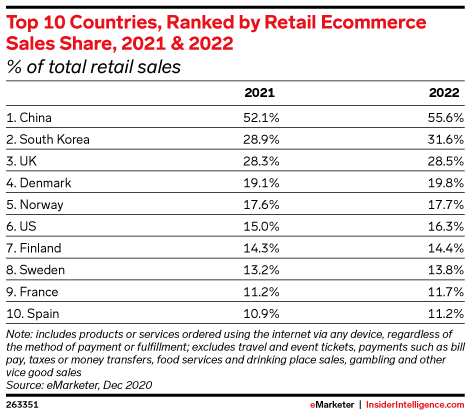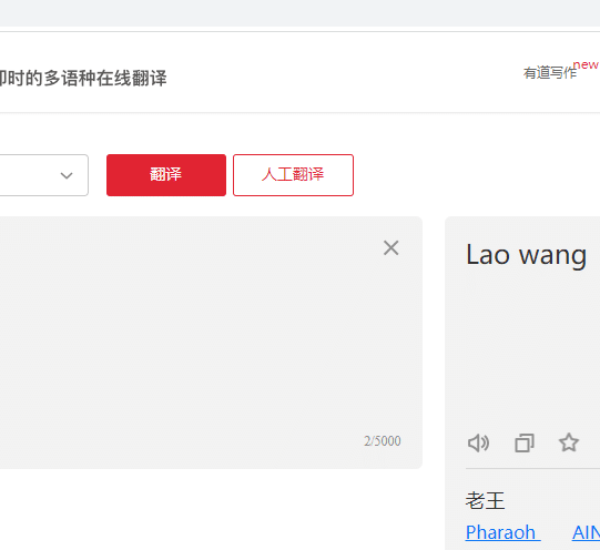Recently updated on January 12th, 2024 at 10:04 am
Table of Contents
China is a tantalizing prospect for any e-commerce company in the world with its over 900 million internet users, and second-to-none retail sales accounting for 52.1% globally. In this article, we’re looking into the top 5 China ecommerce trends to understand why it’s growing at such an unprecedented pace over the years.
The Chinese E-Commerce Market
China’s e-commerce success is unmatched worldwide. From accounting for less than one percent a decade ago, in 2021 China makes up 52.1% of the global e-commerce market.

China is home to some of the leading online marketplaces in the world and they dominate the Chinese e-commerce market. According to Digital Commerce 360’s Top 100 Online Marketplaces ranking, of the top five global eCommerce marketplaces by gross merchandise value (GMV) from third-party merchants, three are based in China: Taobao, Tmall and JD.com, ranking at #1, #2 and #4 respectively.
Competition in the Chinese e-commerce marketplace is fierce as new competitors like Pingduoduo, VIPshop, and WeChat have staked their own claims, and the three e-commerce giants no longer enjoy exclusive market dominance. Understanding the China ecommerce trends is the first step toward building a successful marketing strategy for the Chinese market. Chinese Copywriter’s eCommerce copywriting and marketing teams are here to help international brands break through barriers and achieve success in the world’s largest eCommerce market.
Top 5 China Ecommerce Trends in 2024
Mobile Commerce
As of June 2020, the number of internet users in China has reached 940 million, accounting for one-fifth of the world’s total, and it’s more than the total internet users of the US and Europe combined. With these figures, it’s not surprised that 80% of all eCommerce sales in China are made through mobile devices.
Therefore, businesses regardless of size have attached great importance to mobile optimization as an essential part of their eCommerce strategies. All apps and eCommerce websites are optimized with the customer experience in mind.
Social Commerce
Social commerce is where eCommerce takes place on social media sites. Of the 1.4 billion people in China, 79% are active on social media, spending 5 to 6 hours a day online every day. Different from the social media platforms and instant messaging APPs in the West, many brands open online stores inside popular messaging and social apps, such as WeChat.
The social media APPs in China have a comprehensive range of functions such as socializing, playing games, buying tickets, ordering food, online shopping, etc., and Chinese customers love the integration of all functions in a single platform with a mobile payment feature. Indeed, many of the newest social media platforms in China are integrating fast to become eCommerce marketplaces.
Live Streaming
Live streaming is huge in China and a significant contributor to the country’s e-commerce surge in recent years. With live streaming, eCommerce merchants host live video events that promote products on their own sites or work with KOLs to market brand products.
KOLs, short for key opinion leaders, are often hired for live streaming, to showcase the products, try them on, and describe them to the viewers. Like the QVC shopping channel in the US, the audience can ask real-time questions, while discounts and limited quantity statistics flash across the bottom of the screen. What’s neat about live streaming is the audience can buy products with just one click.

Digital Payment System
Digital payment has become the primary payment method in China accounting for $620.5 billion in Chinese online sales. In 2020, 77.6 million people were using mobile wallets as payment in China. The China ecommerce trends are powered by popular home-grown digital wallets from Tencent’s WeChat Pay and Alibaba’s Alipay. They’re the most preferred payment methods in terms of accessibility, ease of use, and the speed in which they became embedded into online (and brick-and-mortar) checkout options.

Customer Service
Customer service is paramount in Chinese ecommerce trends and customers demand a personalized experience when they seek product information from brands. Different from the West, bargaining for prices online can even be regarded as an essential part of the purchasing experience in China. That’s why most Chinese consumers expect instance customer service representatives to answer their questions immediately.
Since the customer journey tends to begin with social and friend suggestions, followed by customer recommendations and reviews, a final conversion through mobile payment relies on having a genuine shopping assistant service at the moment of sale.
Frequently Asked Questions
What is the Largest E-commerce Company in China?
Alibaba is China’s largest e-commerce company with a revenue amounted to around 853.1 billion yuan in fiscal year 2022.
What Are the Top 15 E-Commerce Platforms in China in 2024?
1. Taobao (淘宝)
2. Pinduoduo (拼多多)
3. JD (京东)
4. TMall (天猫)
5. Xiaohongshu (小红书)
6. 1688 (Alibaba, 阿里巴巴)
7. Dianping (大众点评)
8. Amazon China (亚马逊中国)
9. Suning (苏宁)
10. Meituan (美团)
11. Vipshop (唯品会)
12. Dangdang (当当)
13. VMall (华为商城)
14. Xiaomiyoupin (小米有品)
15. NetEase YanXuan (网易严选)
What’s the Chinese Black Friday?
The Chinese Black Friday falls on Singles’ Day (November 11th), also known as Double 11 (Chinese: 双11), the biggest sales day in China.
What’s the Origin of Chinese Singles’ Day?
Singles’ Day was created in 1993 by Nanjing University students as a kind of anti-Valentine’s Day. It was adopted by e-commerce giant Alibaba as a shopping holiday with its growing popularity among Chinese youth.

Translation Manager
Eva has 6 years of experience working as a News Editor and 5 years as a freelance copywriter. She holds a bachelor’s degree in English from the Guangdong University of Foreign Studies and a master’s degree in applied Linguistics from the University of Melbourne.



